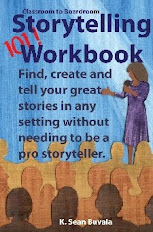Knowing a few good storytelling tips can make your presentations better. If you want an effective ways to share a story, you will find that storytelling is one of the best ways to make an impact with story. I've listed nine basic storytelling tips below for you to think about whenever you want to create a storytelling experience.
1. Select a story you like.
Choose a story you like wherever you are telling: for kids at the library, for a sacred setting or to leaders of business or nonprofit groups. There are so many stories in the world. Take advantage of that variety. Use the ones you like.
2. Work to understand your story.
You need to know how to tell a story. You need to hear or read the story multiple times. Think about your story as parts and not a whole when you are learning. A video camera and a friend who can be gentle yet honest with you will help as you practice.
3. Take out the parts of the story that slow down the action.
Beginning storytellers will hear or read a story and then try to retell every nuance of the story. With each audience, you will remove the parts of the story that do not fit for that audience. Think, "Is this piece required this time? Is it critical?"
4. Speak clearly.
You have chosen a good story and prepared well. You will be confident. Speak with clarity and confidence. Remember you basic speaking skills of enunciation and projection.
5. Use good pacing.
When you are confident, you will not be in a hurry. You want to speak slow enough so that the story is easily absorbed by the audience but do not speak so slowly that their minds check out of the room.
6. A microphone is required.
Use the microphone. Respect the group enough to let them hear you speak. That is why they came to your talk. If you have much experiences as a public-speaker, you probably need a mic when you have more than twenty-five listeners. Beginners, use the mic unless you are speaking to a few folks at a luncheon round-table event.
7. Keep good eye contact.
Look into the eyes of the audience. Some members of your audience will think you are speaking just for them when they know you look at them as a person, not part of the crowd.
8. Use natural gestures.
"You looked so confident up there. I never know what to do with my hands." When people say this to me, I am thankful that I took the time to prepare which gestures I would use and when I would use them. Make gestures that come naturally to you, but plan and prepare them ahead of time.
9. You can skip the here-is-what-to-learn conclusion.
Stories teach. Storytelling is a most effective way to teach with story. Your story gets diluted when you attempt to tell people how to feel and think about that story. If you can't resist telling the moral, at least let the audience speak first. Their answers might teach you.
I've shared 9 storytelling tips to help you create a story with good storytelling. Newbie or veteran speaker- take these nine easy steps into your next speech prep.
***
The official blog for K. Sean Buvala, storyteller and storytelling coach.
Subscribe to:
Post Comments (Atom)





No comments:
Post a Comment